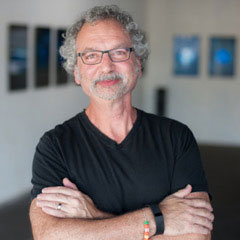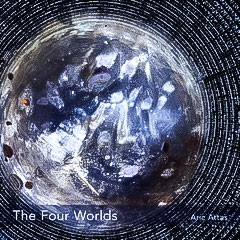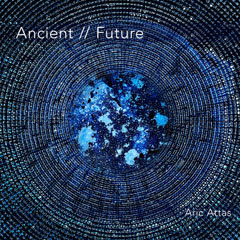Blog > Post
Wotja Artist Perspective - Aric Attas
30th May 2023 by Tim Cole
Tim: Tell us a bit about yourself Aric
Aric: I'm an artist and two-time cancer survivor who believes he's a two-time cancer survivor because he's an artist. I make abstract photographs, immersive video installations and ambient sound environments. Inspired by modern science and the myths of ancient spirituality, my art explores the mysteries of the universe. If you've ever looked up at the stars and felt a sense of wonder, of awe or transcendence you understand what motivates me to make art and music.
I have a BS in Psychology from Hobart College and an MFA in Photography from the Hartford Art School. I've won a number of awards for my work and have been widely exhibited. My approach is to use art, music, workshops, creativity coaching and lecturing to share the healing power of creativity with others.
Tim: How/when did you first come across our generative music systems?
Aric: I can actually remember the exact moment. It was in 1996 at an exhibition called The Shape of Sound at Exit Art in New York. The music curator was Ben Neill and the exhibition featured Brian Eno's 'Generative Music 1'. I understand that you and Pete were instrumental in making this happen by creating SSEYO Koan, Wotja's predecessor, and sending a copy to Eno for him to experiment with.
I was already familiar with the concept of process music, having listened to recordings like Steve Reich's 'It's Gonna Rain' and Eno's 'Music for Airports'. Around the same time, I was reading 'A Year With Swollen Appendices': Brian Eno's Diary which includes some of his essays on this relatively new way of thinking about and creating music (and it also has several references to his work with SSEYO Koan).
The Shape of Sound at Exit Art was the first time I heard generative music unfolding live. I was fascinated by the process but I was even more intrigued by the music.
I rediscovered SSEYO Koan, now Wotja, in 2017 at Boston's Logan International Airport. I was returning to Florida after giving a gallery talk at the opening of my exhibition 'A Glimpse of Infinity'. While waiting for my flight I began searching for software to sonify my images which resembled star fields, galaxies, nebulae and planetary surfaces.
Up to this point I had been making playlists to use as soundtracks for my exhibitions. These included music by Brian Eno, Stars of the Lid, Telomere, etc. The playlists gave me the atmosphere I wanted, but I began to feel very strongly about creating my own music to go with my visual art. I tried several apps but was dissatisfied with the jarring sounds they generated. Then I came across Wotja and was immediately captivated. It was exactly what I had been looking for and I've been exploring ever since.
Tim: What is it that appeals to you about generative music?
Aric: Words like infinite, organic, alive and impermanent come to mind. Philosophically, generative music fits perfectly with my approach to art making and meditation. It exists in the moment and is non-repeatable. Creating generative music is less about exerting control and more about exploration and discovery. Listening is essential. Generative music has an experimental quality that I find very appealing.
I love that the music I create with Wotja is always new, constantly evolving. Unique layers of sounds, textures, timbres and tonal clusters emerge each time I listen. Being surprised as the music unfolds is wonderful and expansive.
I've been exploring the infinite in my visual art and meditation practice for several decades. It makes sense to make infinite music.
Tim: What do you use Wotja for and how do you use it?
Aric: I've been using Wotja to create atmospheric soundtracks for my art exhibitions and video pieces. It adds a layer of depth to my visual work and is also perfect to listen to while creating in the studio, practicing meditation, sleeping and doing healing work. I find the music stimulates creativity, relaxation and a sense of well-being.
Part of my creative practice includes playing music for cancer patients while they receive chemotherapy. The effect of ambient music in a medical environment can be profound. I've seen patients in an anxious, uneasy or agitated state become calm, relaxed and peaceful within moments of putting my music on. One patient told me she felt like she was sitting under a beautiful waterfall of sound. She was glowing with joy. Mind you, she was sitting in a chemo chair receiving an infusion at the time.
I recently came down with Covid and spent several sleepless nights tossing and turning. Struggling to get comfortable and avoid coughing, I looped my tracks Ancient // Future and The Four Worlds, both composed with Wotja. Each time I woke up, I experienced a soothing feeling of being immersed in a healing cocoon of sound. The music didn’t cure my fever, but it definitely made it easier for me to relax and recover.
Most of the time I work entirely within Wotja using the various oscillators, wavetables, LFOs, envelopes, samples and effects to create. I've also explored mixing in field recordings and other sources. Occasionally, I'll use MIDI from the Wotja Music Engine (WME) to trigger other instruments. This can sometimes produce unexpected results leading to new ideas and approaches.
I often start by creating a new automatic mix. The recent additions of Flows 'Only Drones', 'Only Pads', 'Only Piano' and variations of 'Mixed' are really helpful for getting started and discovering new ideas.
I feel my approach to making music derives more from the perspective of an artist than that of a musician. Although I've played music since I was about 10 years old (I started with guitar and added bass a few years later) I'm working more like an abstract painter, applying and removing layers of paint of varying opacities. I'm not approaching it as a traditional composer might, with specific melodies, harmonies and rhythms in mind. I'm more interested in discovering something new as I work — evolving layers of sounds and textures that evoke a sense of wonder or floating in space. I'm especially interested in creating music that takes me on a journey. Transcendence, perhaps.
Tim:What do you find are the most useful aspects of Wotja?
Aric: I love that it allows for an experimental approach to music making. Tapping the automatic mix button allows me to go through quick iterations. If I don't like what Wotja serves up, I move on to the next iteration. This allows me to create from a purely intuitive place. If the sounds resonate with me, I'll start to dig in and tweak. If not, I delete and move on. This helps me invest time and energy into pieces that are already working in some way rather than getting attached to a piece because of how difficult it was to program the sounds. Making art doesn't have to be hard.
Of course, there are times when I have a specific idea or sound in mind. It's just as easy to open an empty mix and begin building synth networks, effects chains and/or importing pre-made elements and tweaking from there.
The sounds and effects in Wotja are amazing! Occasionally I venture out to find new sounds but as my patching skills improve I find myself doing less and less of that. Each version comes with new sounds and effects that expand the sonic possibilities. I love the recently added Reverb 2XL. It's perfect for the spacey, ambient atmospheres I like to create.
Tim: What do you want to do next with Wotja?
Aric: I'd like to dig into some of the scripting possibilities. The ability to have a piece respond to time of day or other factors is fascinating to me.
Until now, my music has been mostly for me. I've shared it with a few close friends, my meditation group and the cancer patients I work with, but now I feel it needs to go out to a wider audience through collaborations, sync licensing, etc.
I'd also like to continue exploring the healing properties of sound through sound installations, meditation apps and programs that combine arts and medicine. I'm very interested in collaborations with other artists, filmmakers, programmers, scientists, doctors, yoga studios, wellness centers, etc.
Some day I'd like to sharpen my skills enough so that I can use Wotja to improvise a live set of generative ambient space music surrounded by my photography and videos.
Tim: Thank you Aric!
On behalf of Intermorphic I would like to thank Aric for his interesting and insightful answers. I think you will be able to tell that Aric is an amazing guy and we wish him all the best in all his many artistic endeavours.
If you would like to learn more about Aric and his art and music, then visit Aric at:
- http://photonlab.com
- https://www.healingpowerofcreativity.com/
- https://aricattas.bandcamp.com/
- Apple Music
- Spotify
Aric: Thank you Tim. I have to say that Wotja has been an essential element in my development as an artist and has truly helped me discover my voice as a musician. I am grateful to you and Pete for your creativity and generosity.


